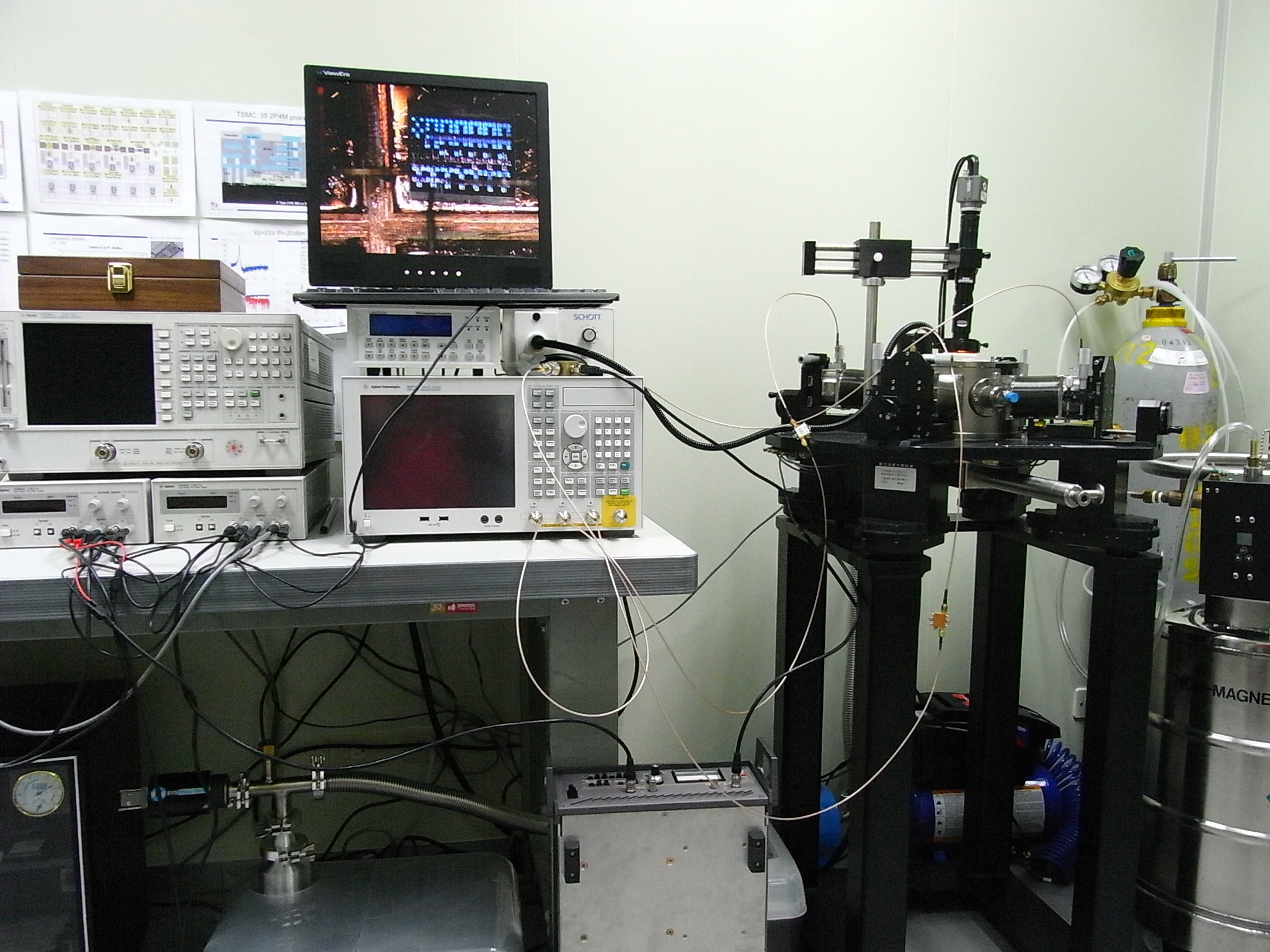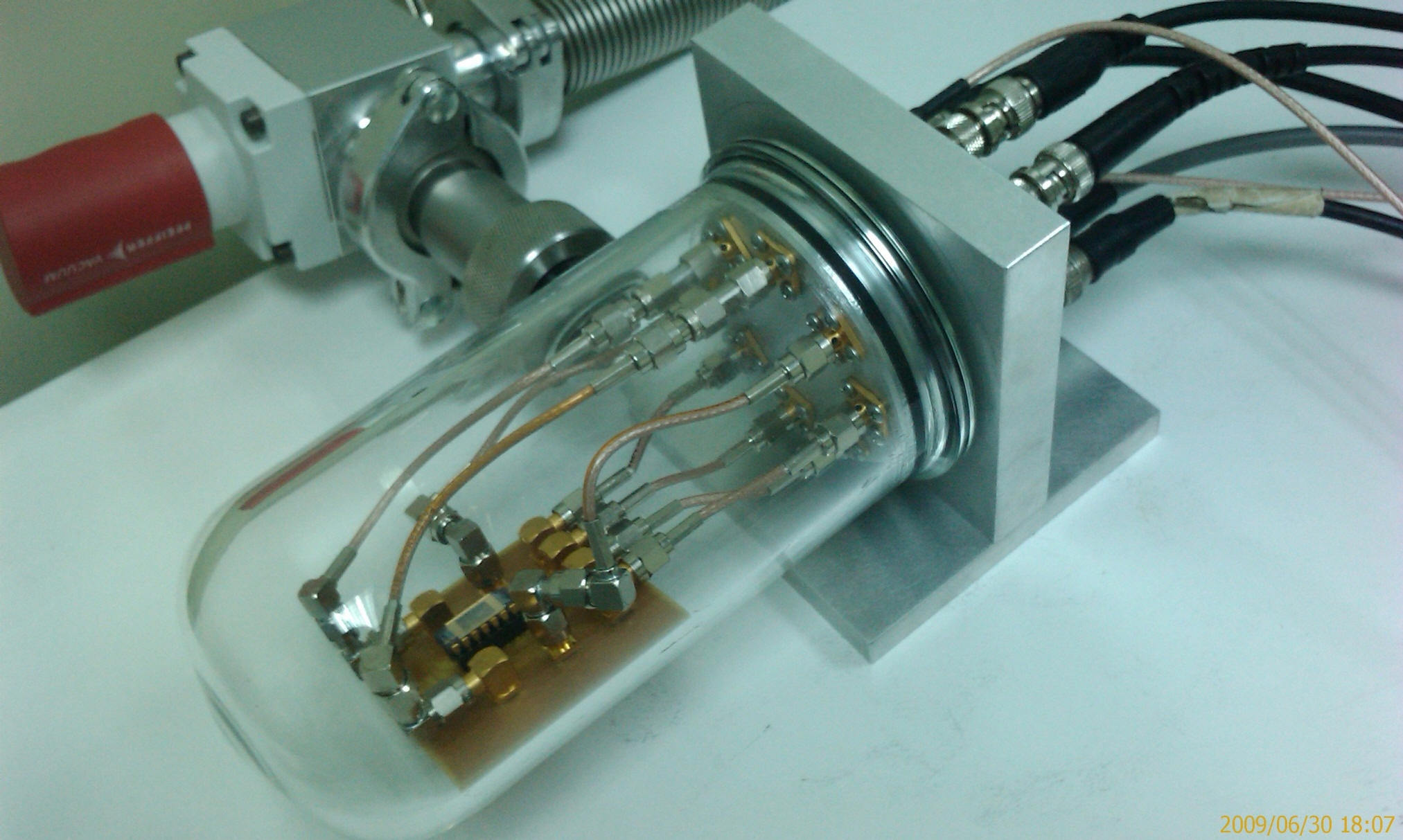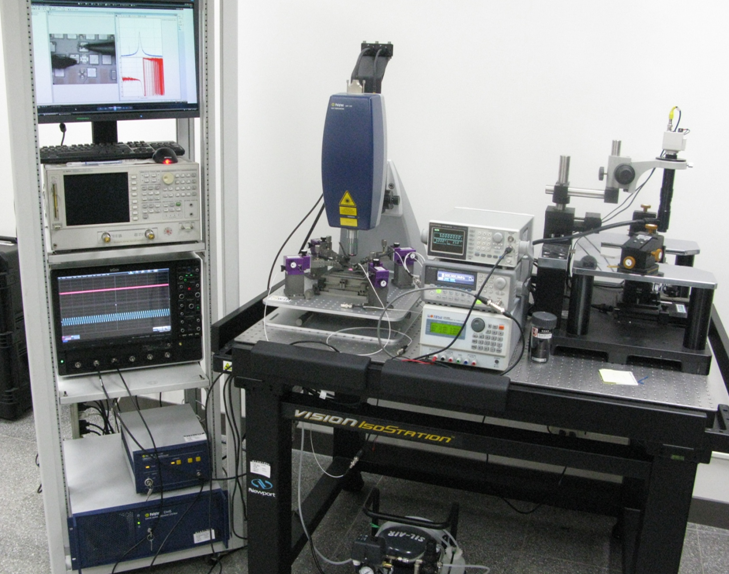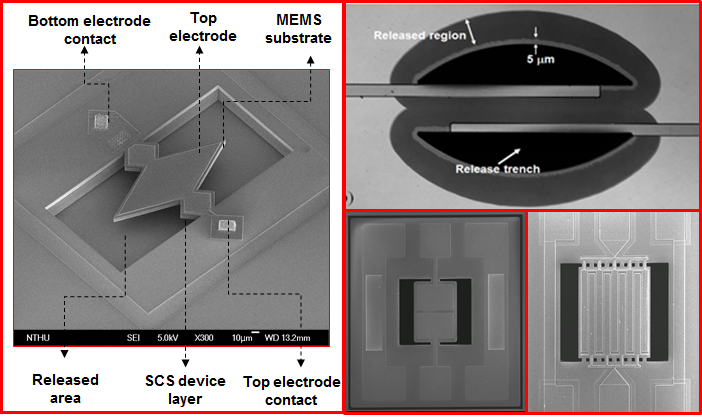
Piezoelectric MEMS Resonator
The piezoelectric thin films used currently are Lithium Niobate , Aluminum Nitride and Lead Zirconate Titanate (PZT). High performance resonators varying from Medium Frequency to Super High Frequency has been realized using in house and commercial fabrication platforms.
We work on piezoelectric thin film resonators and also thin film on substrate configuration to utilize the low insertion loss and high electromechanical coupling of piezoelectric transduction and high quality factor or TCF compensation feature of the substrate.
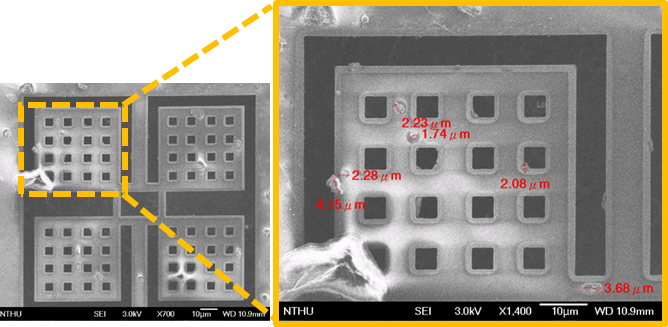
MEMS Particle Sensors
We have proposed the particle sensors utilizing not only the in-house SOI process but also CMOS-MEMS platforms. The thermal-piezoresistive resonator (TPR) combined with commercial PLL amplifier successfully detected PM2.5 particle calibrated by a commercial optical aerosol sensor (OAS).
Moreover, in order to verify the mass sensing capability, a pico-liter ink jet printing setup was used to demonstrate the real time response and frequency shifts corresponding to a number of droplets printed onto the proof-masses of the thermal-piezoresistive oscillator (TPO).
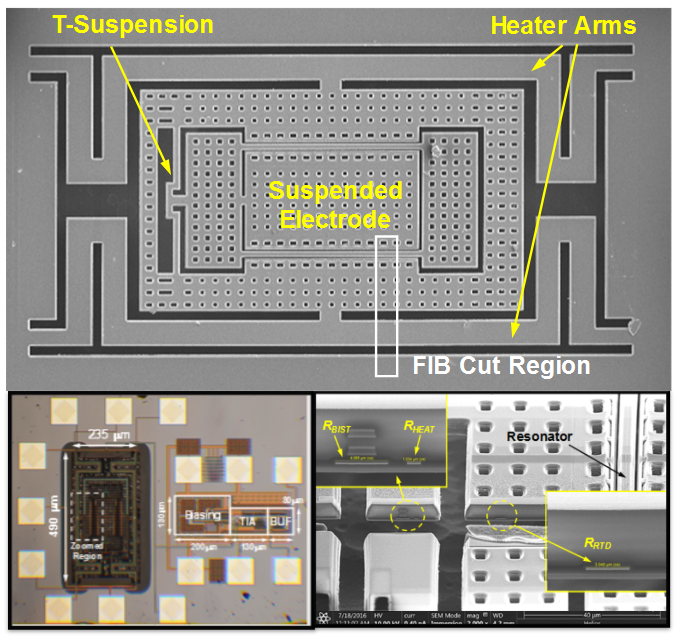
Ovenized CMOS-MEMS Oscillator
To improve the frequency stability of the micromechanical resonator, we proposed an ovenized scheme by using embedded heaters to maintain the temperature on resonant tank.
With constant current control, a high thermal stability ovenized CMOS-MEMS oscillator has been successfully demonstrated in vacuum, integrated with built-in self-test for fully integrated sensor fusion.
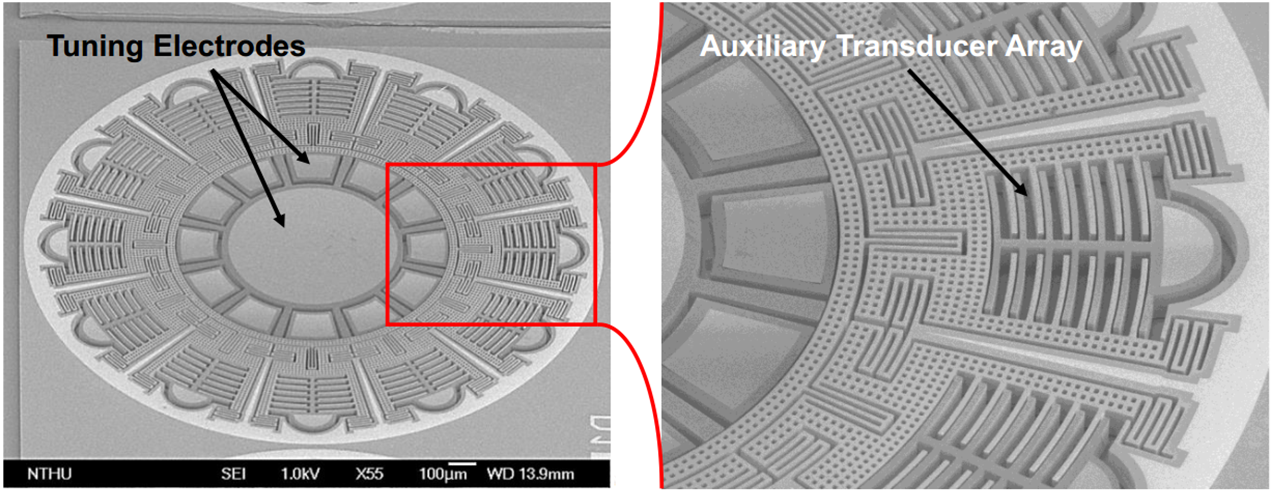
MEMS Gyroscopes
A ring-enhanced mode-match gyroscope has been developed with in-house process. With the adoption of trefoil mode(n=3), the frequency split of the driving and sensing mode of the device is only 225ppm in preliminary characterization.
The resolution of 0.26deg/s is achieved in atmospheric pressure, and is expected to reach tactical grade specs once vacuum package is available.
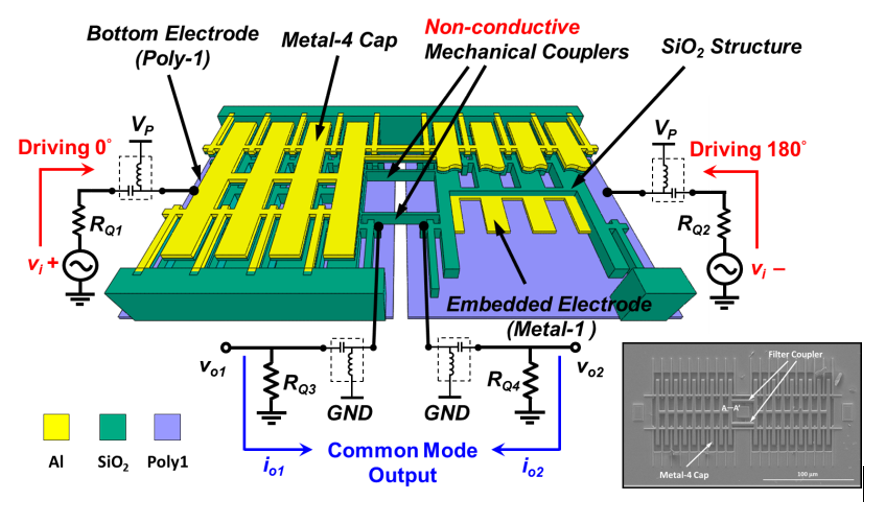
CMOS-MEMS Mixed Coupling Filter
In this work, a channel selection MEMS filter with a novel mixed coupling scheme is realized by a standard 0.35 um CMOS technology. To attain a low-loss filter implementation, the considerable Rm for such a capacitive device is reduced by engineering the Q-factor, transduction area, and transducer’s gap, thus relaxing the requirement of termination resistance for the impedance matching of a given filter.
Moreover, the mechanically-coupled spring and differential operation are simultaneously implemented. The presented design offers two advantages as compared to traditional filter topologies, including (i) larger stopband rejection than the typical two-port configuration; (ii) well-defined bandwidth against the electrically-coupled (i.e., parallel-class) filters.
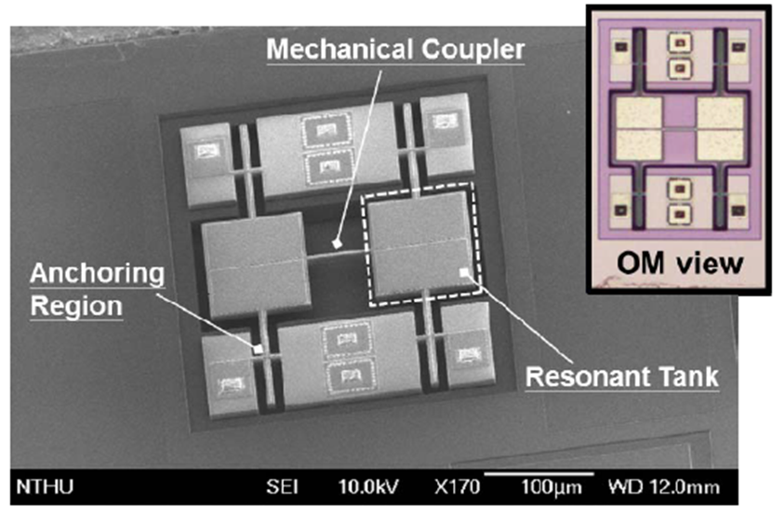
Piezo-MEMS Filter Design
We propose a novel mechanically-coupled filter design which for the first time combines two distinct physical vibration modes, including length-extensional (LE) and degenerate in-plane shear (IPS) modes excited in a single filter structure, fabricated using InvenSense AlN-on-silicon platform.
By taking advantage of typical LE-based (LE-LE) and IPS-based (IPS-IPS) monotonic filter designs but without their inherent constraints, the proposed non-monotonic coupled mode (IPS-LE) filter simultaneously features a nodal-point positioned filter coupler and a differential operation, hence enabling narrow-band filtering and significant feedthrough reduction toward channel-select applications.
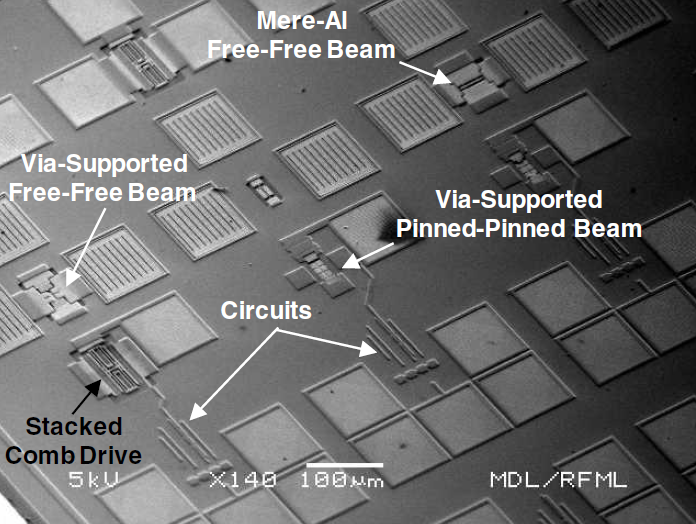
CMOS-MEMS Resonator Platform
We have developed several CMOS-MEMS resonator platforms co-fabricating mechanical resonators and their amplifier circuits for MEMS/IC integration.
The foundry-oriented CMOS-MEMS platform provides ease of use, low cost, fast prototyping, and circuit integrated features for vibrating RF-MEMS applications.
This platforms can be mainly categorized into two different release methods - oxide removal and metal removal maskless post-CMOS processes, implemented in both 0.35um 2-Poly-4-Metal (2P4M) and 0.18um 1-Poly-6-Metal (1P6M) CMOS technologies.
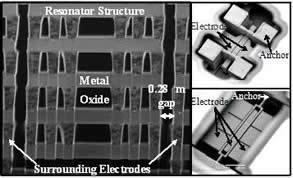
Advanced CMOS-MEMS Resonator
To address the issue of high motional impedance, we transfer this oxide removal process into a 0.18um CMOS where the cross-sectional and physical views are shown in figure.
The electrode-to-resonator gap spacing is reduced via the minimal feature size of the 0.18um CMOS (1.8X smaller than the 0.35um CMOS) while the transducer area can be increased by the 6-metal stacking (4-metal stacking in the 0.35um CMOS).
The combined merit of the gap and area contributes to much lower motional impedance as compared to the 0.35um CMOS-MEMS resonators.

CMOS-MEMS Oxide Resonator
Although the oxide removal process only requires one maskless wet etching step, the metal-rich feature resonators places a bottleneck on quality factor Q since the structural aluminum is often treated as a high-loss acoustic material.
A simple way to overcome this structural loss is to increase the constituent ratio of the SiO2 (i.e., low-loss material) inside the resonator, thus enabling high Q.
The oxide-rich CMOS-MEMS resonators feature 3-4X higher Q than that of the metal-rich versions

RF CMOS-MEMS Switch
A micromechanical actuator fabricated using a foundry-oriented CMOS-MEMS process has been demonstrated with low actuation voltage via the pull-in aided frame design for RF-MEMS switch applications.
With such a two-stage mechanical support design, the actuation voltage of the proposed actuator has been reduced by 35% as compared to that of the conventional one-stage design with the same offstate gap spacing.
The switch design methodology and foundry-type fabrication technology bring mechanical on/off switching capability into high-Q CMOS-MEMS circuits for future multimode, multi-band wireless communication systems.
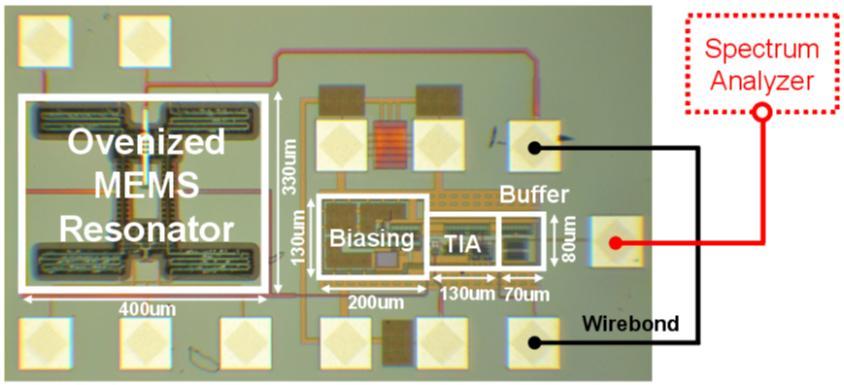
Co-integrated CMOS-MEMS Microsystems
The micromechanical resonator and its sustaining amplifier can form a closed loop to ensue oscillation once Barkhausen criteria are satisfied.
In our group, a single-chip CMOS-MEMS oscillator has been successfully demonstrated in vacuum, exhibiting the output waveform and phase noise performance, which is comparable to the silicon-based oscillators.
Live Demo: CMOS-MEMS ocsillator operating in air !
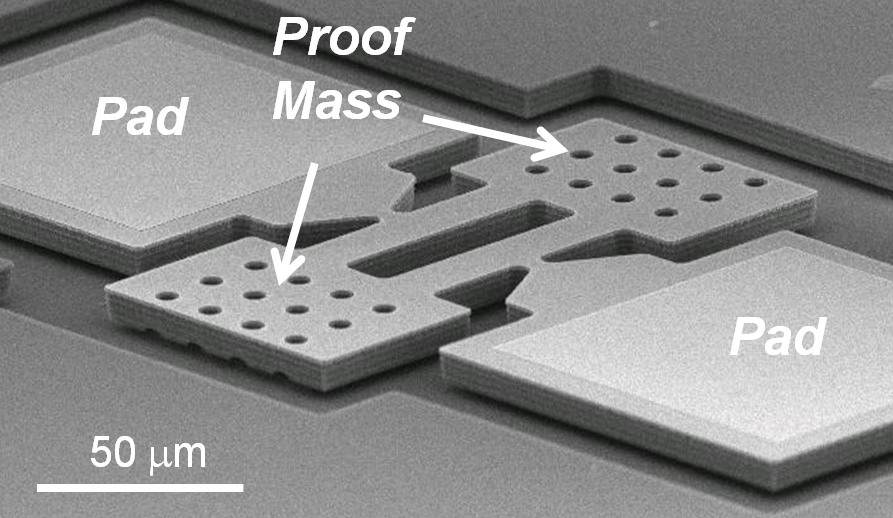
SOI Thermal-Piezoresistive Resonators
We proposed a methodology to enhance thermal stability of MEMS resonators by the use of a constant-structural-resistance control where temperature coefficient of resistivity (TCR) of the MEMS resonator serves as an instrinsic temperature sensor, thus leading to a constant structural temperature to greatly alleviate the frequency drifts due to change of ambient temperature.
The SOI-based thermal-piezoresistive MEMS resonators feature simple fabrication process, high Q in air and liguid, and high power efficiency when miniaturization for sensor applications.
